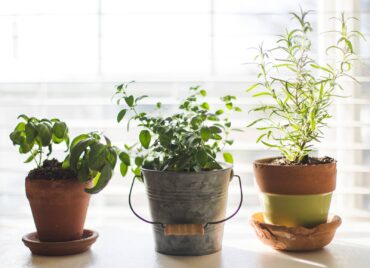 Even if you have an outdoor garden, it’s always nice to have a few herbs growing in your kitchen. Whether you live in a home, apartment or condo, you’ll appreciate having fresh herbs at your fingertips.
Even if you have an outdoor garden, it’s always nice to have a few herbs growing in your kitchen. Whether you live in a home, apartment or condo, you’ll appreciate having fresh herbs at your fingertips.
It’s relatively easy to grow an herb garden in your kitchen, but a few things are critical for success. We’ll show you how to grow herbs successfully indoors along with five easy-to-grow plants.
Let the Sun Shine
Herbs need a lot of sun, which indoors translates to light, either real or artificial. The best place to grow herbs in your kitchen is in the sunniest space. This could be a window sill or a table placed in front of a sunny window. If you’re growing several plants, rotate their spots weekly.
If a sunny window is not an option, hook up artificial lights. Fluorescent bulbs are the simplest and most available. For decades, fluorescent bulbs were the go-to indoor lighting for plants. Unfortunately, their intensity would not support flowering or fruiting plants, but they are strong enough for a culinary herb garden.
More efficient and longer-lasting fluorescent lights or LED tube lights are available today. Even with these fancy lighting options, nothing beats a sunny spot in your home, even if it’s not in your kitchen.
Watering Herbs in Your Kitchen
Treat your herb garden like your houseplants. Water them as needed in your kitchen sink until water seeps from the drainage holes. Similarly, place your herb pots in the sink with a couple of inches of water. The soil absorbs water from the bottom up. Remove your pots when the topsoil feels moist.
Most herbs are not water hogs. Basil has the highest watering needs of the culinary herbs, and herbs are best watered only when the soil feels dry. Avoid watering with treated water or water run through a softener.
Insects and Diseases
Your indoor herb garden is not immune to pests and disease. Common indoor pests like aphids, spider mites, whiteflies and fungus gnats may invade your new culinary kitchen forest. While some insects like spiders are beneficial to your garden, most indoor infestations require regular inspections and quarantining if you notice pest activity.
Common indoor diseases include powdery mildew, root rot and gray mold. Avoid overwatering and overhead watering to prevent these moisture-related diseases.
Where to Buy Herbs for the Kitchen Garden
Buy herbs at garden centers, home improvement stores, grocers and farmers markets. Herbs that already grow in pots are an easy and great way to get started with your kitchen garden. If you’re up for a little challenge, you can grow herbs from seeds.
Keep in mind that there are annual (basil), biennial (parsley) and perennial (oregano) herbs. Herbs can also be woody, such as thyme. Usually, annual herbs are the easiest to maintain in a kitchen garden.
Planting Herbs for Your Kitchen Garden
If you purchased prepotted varieties, simply give your herb a new home in a sunny location. However, if you want to repot your new herb, select a pot that is only an inch or two wider than your existing pot.
Use a high-quality potting mix to grow your herbs, and select pots with drainage holes. Optionally, cover the holes with a bit of wire screen or a piece of paper to allow water to drain while retaining the soil. Saucers under your pots protect your window sills or table tops.
Six Easy Herbs for Your Kitchen Garden
Grow herbs you want to use in your Washington kitchen garden. If you don’t like sage, don’t grow it. If you can’t get enough cilantro, grow several pots of it. Here are six herbs to get you started:
Annual:
- Basil
- Cilantro
Biennial:
- Flat-leaf parsley
- Curly-leaf parsley
Perennial:
- Culinary sage (Salvia officinalis)
- Oregano
Kitchen Gardens in Western Washington
Growing an herb garden in your kitchen can be a rewarding and practical experience. Herbs add fresh, aromatic flavors to your cooking and also offer a touch of natural beauty to your home.





















Comments